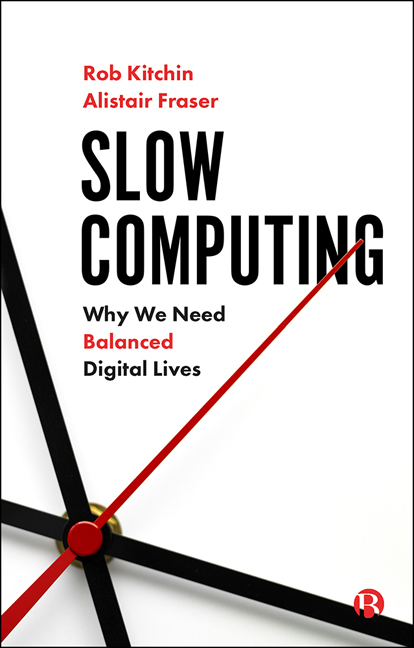Book contents
- Frontmatter
- Dedication
- Contents
- About the authors
- Acknowledgements
- 1 Living Digital Lives
- 2 Accelerating Life
- 3 Monitoring Life
- 4 Personal Strategies of Slow Computing
- 5 Slow Computing Collectively
- 6 An Ethics of Digital Care
- 7 Towards a More Balanced Digital Society
- Coda: Slow Computing During a Pandemic
- Notes
- Index
4 - Personal Strategies of Slow Computing
Published online by Cambridge University Press: 12 March 2021
- Frontmatter
- Dedication
- Contents
- About the authors
- Acknowledgements
- 1 Living Digital Lives
- 2 Accelerating Life
- 3 Monitoring Life
- 4 Personal Strategies of Slow Computing
- 5 Slow Computing Collectively
- 6 An Ethics of Digital Care
- 7 Towards a More Balanced Digital Society
- Coda: Slow Computing During a Pandemic
- Notes
- Index
Summary
Thursday. It's 1pm. You’ve been trying to change how you work. You arranged to meet a colleague for lunch by emailing her yesterday, rather than contacting her via WhatsApp today. You’ve spent the morning working in a focused way, ignoring email and messages, and staying away from social media. Before heading out of the office you’ve just caught up on those communications in a quick intensive session and placed your phone on silent. Lunch feels a little strange because you leave your phone in your pocket and not on the table next to your plate. You describe the morning to your friend: how you read a book on the train for the first time in years (and how odd that felt when everyone around you was on their phone); how you’ve purposefully been using a new web browser that hides your IP address; and how you’re more carefully curating what you share online. She doesn't seem too impressed, but it has actually felt like a good move to you; certainly, it's been different and, yes, it's been a little bit inconvenient. But it has also felt liberating.
Hopefully this scenario sounds appealing and achievable. We think it starts to set out what a slow computing day might look like. As we pointed out in Chapter 1, slow computing is a means to address the various issues that acceleration and data extraction create. It seeks to do this in a way that prioritizes and protects your needs and interests, and creates public good for society as a whole. Practising slow computing requires individual and collective actions: people making decisions to change how they lead their digital lives by considering and changing their own situations, and pooling their actions and drawing on the diverse actions of others.
This chapter focuses on tactics you individually can use to fulfil the strategy of slow computing. It is about taking ownership of the issue and being proactive in tackling acceleration and extraction at a personal level. To that end, we set out some interventions aimed at slowing down your computing. We emphasize reconfiguring the time you spend on your digital participation, while curating and limiting the extent to which you leave data footprints and cast data shadows. Adopting these ideas can be empowering because it can give you back a degree of control.
- Type
- Chapter
- Information
- Slow ComputingWhy We Need Balanced Digital Lives, pp. 76 - 108Publisher: Bristol University PressPrint publication year: 2020



